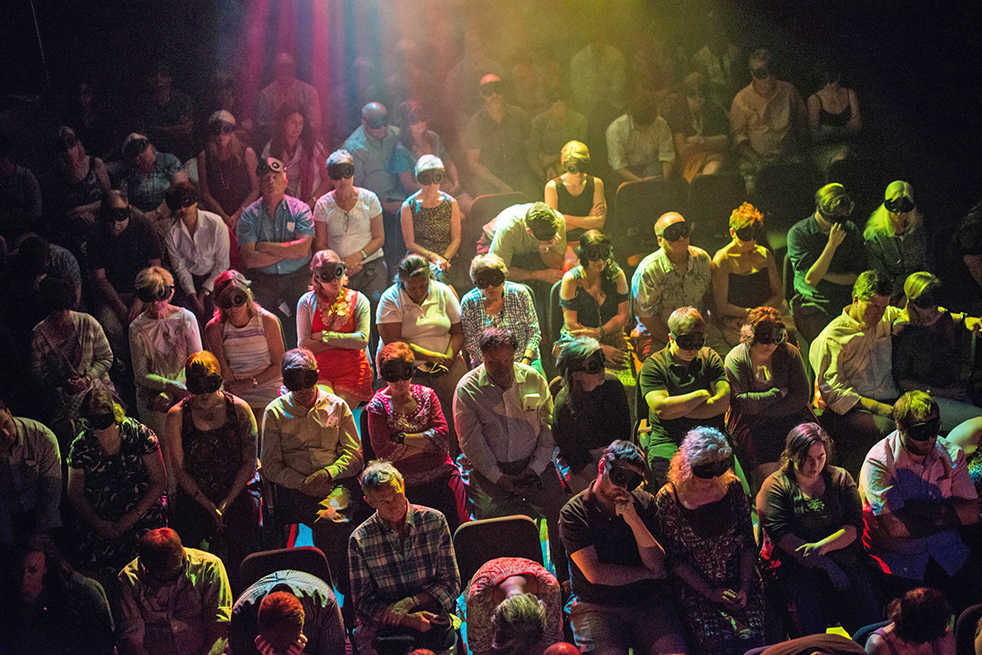Last week, the Ferst Center for the Arts hosted EarFilms’s first work, “To Sleep To Dream.” The decidedly innovative production spurned any normal performance standards and opted instead to blindfold its audience and envelop them in the sounds of its story.
The 3D sound system was intended to evoke the imaginations of the listeners; the hope of its creators was to ensure a unique experience for everyone. To this end, the audience was assured that there is no wrong answer before the performance even began.
The audience was then instructed to place the provided blindfolds over their eyes and spend the next 90 minutes immersed in the story of Jack Richards (Alistair Parker). Listeners were guided through his post-apocalyptic world of nigh-endless ocean and a single city only by the live narration of Daniel Marcus Clark and a pre-recorded slew of meticulously crafted sound effects and dialogue.
According to EarFilm’s own synopsis, “To Sleep To Dream” is “set in a society where the act of dreaming is outlawed,” but far more thought-provoking is the fact that all communication with others and all creativity of any kind are also against the city’s strictly enforced laws. The future is far bleaker than the synopsis so cheerily indicates.
In this particular dystopia, the audience was introduced to a number, a man whose entire description amounts to male, living and unofficially named Jack. The rest was supplied by the audience’s independent imaginations.
His story began by exploring his everyday life, where he was constantly instructed exactly how to act by an all-seeing female voice (who may or may not have been disembodied but was certainly robotic in nature).
When he leaves his apartment, he was led to the elevator by her cheery “Step. Step. Step.” and later, upon arriving at work, she commended him with “You have enjoyed your tram ride. [Robotic pause] Good job.”
Once the audience had become accustomed to creating the story based solely on sound, the action began. Jack started to dream. Of course, this being the future, he was instantly woken by a clarion call and a cheery “Please return to sleep” from the ever-present voice.
His journey thus begun, the rest of “To Sleep To Dream” followed Jack as he meets other dreamers who have found another world, the Realms, which is only reachable through dreaming. Clearly having nothing better to do in his dystopian life, Jack joined the others in their quest to explore the Realms and to bring vibrancy back to this world and share it with his fellow humans.
At the end of Jack’s story, the audience hesitantly lifted their blindfolds and slowly returned to the dimly lit DramaTech theatre, each having experienced the production in a different manner. Some had visualized exactly what had occurred while others simply listened and felt the story. One person even likened the time spent as akin to a drug-fueled psychedelic journey.
Even with its unoriginal beginning of “flood destroys the world, people carry on,” “To Sleep To Dream” shared a decidedly interesting narrative that easily kept the audience excited and eager for more. Its plot even had the bonus of being easily paralleled with the production itself: the audience and Jack were both experiencing acts of imagination quite out of the norm in their respective societies (granted, no one in the audience feared being arrested for their involvement).
The last in-state production of “To Sleep To Dream” was Mar. 4, and their next performance will be at the Mesa Arts Center in Arizona on Mar. 15. EarFilms is currently having “To Sleep To Dream” translated into French and has already shown it in Mandarin Chinese. In the future, they hope to create more films using their immersive sound system and are currently working on shorts for personal headphones listening.
